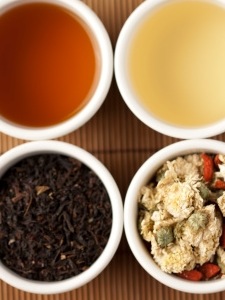Tea Blending Tips, part I
At some point as a tea business owner, you may wish to create something unique for your shop or recreate something you can no longer get from a vendor. Let us share some basics of tea blending to get you started.
First, keep a notebook to track your experiments by writing down the various versions of your blends. Record keeping is very important!

Professional three-part cupping sets are helpful to have as well, so you can simultaneously brew all the versions of your blend for comparison under identical parameters. Small bowls are helpful for blending small batches, big bowls for big batches. Metal spoons are great for mixing.
Gram scales ensure you are accurately measuring the leaf. If what you think is a 50/50 blend is a little more 40/60, you can be sure by weighing the leaf for each tea prior to adding to your blend.
Be careful – measure into separate bowls before combining the ingredients. This is so you can double check the weights of each ingredient and ensure accuracy (and limit confusion and waste.)
Keep a list of how much of each tea (or other ingredient) you intend to add to a blend and check it off as you add to the main bowl to prevent errors.
Start simply. Try using pre-blended teas to create your blend, and start off with two teas. Blend them in an equal part mix – or 50/50. For example, measure 5 grams of tea A and 5 grams of tea B to your blending bowl and mix thoroughly but gently. Don’t crush the leaves! Then measure just over 2.5 grams of tea A and 7.5 grams of tea B for a 25/75 blend and vice versa for a 75/25 blend. Make a note by each batch so you don’t lose track of which tea is which formulation.
Once you’ve made these three versions, measure 2 grams of each blend into separate brewing cups and follow the normal steeping recommendations for the most delicate tea in the mix (to prevent over steeping.) Then compare how each formulation tastes, determine which is preferable and note how the flavors combine.
For example, if you were blending a lemon tea and a cream tea, which formulation has the best balance of flavors? Does the cream bury the lemon at the 75% cream to 25% lemon formulation? Is the cream lost when using a 25% cream and 75% lemon ratio? Make notes about each and ponder other percentage options. As you test different flavor combinations in this manner, you learn how flavors work together. This will build your blending repertoire for future projects and let you achieve the desired taste most quickly.
In the next exercise, try three different flavors at 33% each. Which flavor gets lost and which dominates? Good luck!

